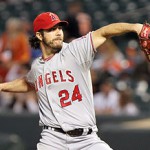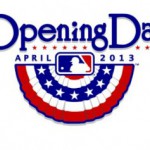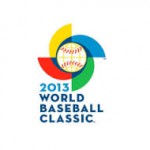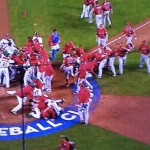
Despite going to Madison, I've never seen this seal until googling it.
Vienna High School baseball continues its dominant ways, with the #1 DC-area Ranked Madison Warhawks and their next-door neighbor rival Oakton Cougars both taking home district tournament titles on 5/20/13.
Madison blew through the Liberty District, getting a bye into the semis, winning in the semis against Stone Bridge 11-0 (with their starter taking a perfect game into the 7th) and then beating the #2 seed Langley Saxsons 11-2 in the final. Oakton beat a couple of Northern Virginia heavyweights in Robinson and Chantilly, the latter in walk-off fashion, for their Concorde District title.
The wins for Madison lately have vaulted them into some national prominence. They’re #20 in the latest Baseball America top 25 poll (mostly b/c so many upper-ranked teams were dropped after losing in their state playoffs). Honestly though I have a hard time putting Madison over Great Bridge HS (#22 in Baseball America), knowing what I know about that Chesapeake team (namely, Conner Jones). USAToday’s latest ranking (dated May 8th so its way out of date) has Great Bridge #17 and Madison as a honorable mention. I’m hoping for a Madison-Great Bridge state final. Update: USA Today’s 5/22/13 rankings now have Madison at #22 nationally with Great Bridge dropping out entirely due to their playoff loss to Western Branch. So much for a Madison-Conner Jones state final I guess.
Both Madison and Oakton advance to the Northern Regional tournament, along with their fellow district quarter and semi-finalists. No schedule yet but the pool of teams looks like this:
- District champs: Madison, Oakton, South County, Washington & Lee
- District finalists: Langley, Chantilly, Lake Braddock, Yorktown
- District qtr finalists: Stone Bridge, Marshall, TC Williams, West Potomac, Centreville, Robinson, Edison and Stuart
The Regional tourney kicks off tomorrow night with this slate (home teams are the higher seeds, here’s the bracket):
- T.C. Williams (11-10) @ Oakton (17-4): a tough matchup for Oakton if TC Williams throws their ace Alec Grosser.
- Stone Bridge (11-11) @ Yorktown (17-5)
- Stuart (15-6) @ Langley (13-9)
- Robinson (10-12) @ South County (14-8)
- Edison (12-10) @ Madison (21-1)
- Chantilly (11-12) @ Lake Braddock (17-4): Lake Braddock has high-end pitching prospect Thomas Rogers finally back from TJ surgery, adding a surprise element to this storied franchise and defending State champ.
- West Potomac (12-8) @ Centreville (15-4)
- Marshall (8-14) @ W&L (13-10); also a tougher matchup here if Marshall throws its lefty ace Mitch MacKeith
Guessing on the seeds: Madison #1, Oakton #2, South County #3 and Washington & Lee #4. Centreville #5, Langley #6, Yorktown #7, Lake Braddock #8. This is slightly different from the district final results (Centreville and Chantilly seem switched if I’m reading the bracket correctly). Madison gets an advantage by virtue of hosting its entire half of the draw plus the Regional semis and Final next week. Regional Final set for 5/31 at 6:30pm at Madison.
Predictions for the tournament: all the home teams hold serve in the first round, then Oakton, South County, Madison and Centreville into the regional semis with an all-Vienna regional final next friday.
5/24/13 results: first round done, here’s the Northern Region tourney results:
- Oakton d T.C. Williams 9-1 (I guess Grosser wasn’t a factor)
- Stone Bridge d Yorktown 1-0 (an upset per seedings and records)
- Langley d Stuart 8-2 (Stuart’s great season comes to an end)
- South County d Robinson 6-1 (a traditional power ends a disappointing season)
- Madison d Edison 13-1 (a predictable blow-out for the region’s #1 seed)
- Lake Braddock d Chantilly 8-2 (Chantilly’s cinderella run ends)
- Centreville d West Potomac 8-2 (no upsets here, setting up an interesting quarter final match)
- Marshall d Washington & Lee 7-0 (an upset by record but perhaps not by overall capabilities)
2nd round Matchups on Monday 5/27/13
- Oakton v Stone Bridge: Oakton beat Stone Bridge 6-2 earlier in the season and is favored here.
- Langley v South County: no prior meetings between the teams, but South County is streaky and has one 5 straight. Close game.
- Madison v Lake Braddock: close matchup by record, no prior meeting but Madison has the advantage playing at home.
- Centreville v Marshall: Centreville beat Marshall away 8-4 to open the season; Centreville favored here.
I’m holding to my predictions made before round 1 for the semis. Oakton, South County, Madison, Centreville.
5/27/13 Results: Big upsets in the Regional quarters:
- Lake Braddock takes out #1 Seed Madison 9-6 on home turf behind Dan Rogers, recovering from TJ Surgery.
- South County edges Langley 4-3 in 13 innings. Wow.
- Oakton steamrolls Stone Bridge 13-5, is now the new favorite to win the region with Lake Braddock.
- Marshall edges out Centreville 5-4, continuing their cinderella run.
Regional Semis on 5/29/13 are set: Its now looking like and Oakton-Lake Braddock regional final. 5/29/13 results: Indeed both Oakton and Lake Braddock won easily and both advance to the State tournament.
- Oakton d South County 8-1
- Lake Braddock d Marshall 16-5.
Regional Final: predicting Oakton but wouldn’t be surprised either way. 5/31/13 result: Lake Braddock batters its way to another Regional crown 14-7.
With the Regional losses for both Great Bridge and Madison, both teams have now dropped out of top-25 rankings in BaseballAmerica and USAToday‘s early June rankings. Great Bridge and now Lake Braddock are Honorable Mentions in USAToday, implying a top 50 national ranking for now.
Virginia AAA State Tournament: with the 5/30/13 results, the 8 participants in the state tournament are now known. From each of the four State Regions:
- Northern Region (Fairfax, Arlington counties): Lake Braddock, Oakton
- Northwest Region (Loudoun, Prince William, Fauquier counties): Hylton, Patriot
- Central Region (Richmond): Douglas Freeman, Hanover
- Eastern Region (Norfolk/Va Beach): Kellam,Great Bridge
Weird how Great Bridge loses early in its own district tournament but still advanced to the Regional tournament, which it subsequently looks to win.
State Quarter finals to be held Tuesday 6/4/13: Lake Braddock v Patriot, Oakton v Hylton, Freeman v Great Bridge and Hanover v Kellam. The semis and final are at Westfields High School friday and saturday Jule 7-8th.
6/4/13 State Quarter final results: local teams and the favorite go through to the semis. Results:
State Semis are Friday 6/7/13 at 3pm and 7pm.
Semis and Final Results: Both NoVa local teams were beaten in the State Semis, setting up a Great Bridge-Hanover state final. In the state final, Richmond area Hanover prevailed over a Conner Jones-less Great Bridge 3-1. Despite a 5-run lead on Friday night against Lake Braddock, Great Bridge left Connor Jones throw 2 2/3 innings in the semi, leaving him ineligible to appear in the championship. This seemed like rather questionable stragegy, considering the way Hanover used their ace Derek Casey to save the friday night game and to pitch the bulk of the state championship game. If you’ve never heard of Casey, you probably will next year. Only a junior, he’s already up to 93 on the gun and has an early UVA commit. I’m sure about this time next year we’ll be hearing about Casey’s draft value.
Congrats to Hanover and Derek Casey for a 2013 Virginia State Baseball Title.




